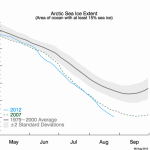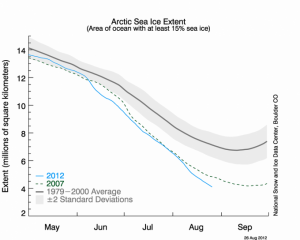from the UC Boulder National Snow and Ice Data Center:
The blanket of sea ice floating on the Arctic Ocean melted to its lowest extent ever recorded since satellites began measuring it in 1979, according to the University of Colorado Boulder’s National Snow and Ice Data Center.
On Aug. 26, the Arctic sea ice extent fell to 1.58 million square miles, or 4.10 million square kilometers. The number is 27,000 square miles, or 70,000 square kilometers below the record low daily sea ice extent set Sept. 18, 2007. Since the summer Arctic sea ice minimum normally does not occur until the melt season ends in mid- to late September, the CU-Boulder research team expects the sea ice extent to continue to dwindle for the next two or three weeks, said Walt Meier, an NSID scientist.
“It’s a little surprising to see the 2012 Arctic sea ice extent in August dip below the record low 2007 sea ice extent in September,” he said. “It’s likely we are going to surpass the record decline by a fair amount this year by the time all is said and done.”
On Sept. 18, 2007, the September minimum extent of Arctic sea ice shattered all satellite records, reaching a five-day running average of 1.61 million square miles, or 4.17 million square kilometers. Compared to the long-term minimum average from 1979 to 2000, the 2007 minimum extent was lower by about a million square miles — an area about the same as Alaska and Texas combined, or 10 United Kingdoms.
While a large Arctic storm in early August appears to have helped to break up some of the 2012 sea ice and helped it to melt more quickly, the decline seen in in recent years is well outside the range of natural climate variability, said Meier. Most scientists believe the shrinking Arctic sea ice is tied to warming temperatures caused by an increase in human-produced greenhouse gases pumped into Earth’s atmosphere. CU-Boulder researchers say the old, thick multi-year ice that used to dominate the Arctic region has been replaced by young, thin ice that has survived only one or two melt seasons — ice which now makes up about 80 percent of the ice cover. Since 1979, the September Arctic sea ice extent has declined by 12 percent per decade.
Read the rest of this piece here and check out this great piece at SkS about why you should care about the loss of arctic sea ice.


Leave a Reply